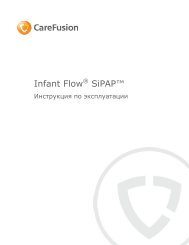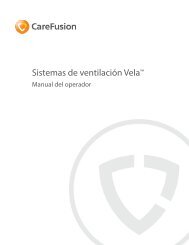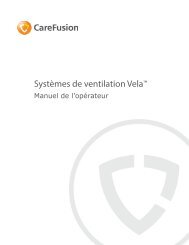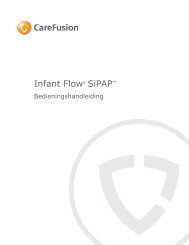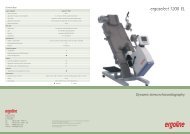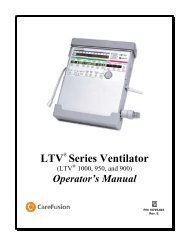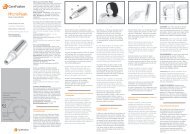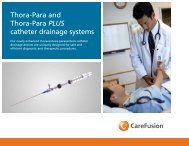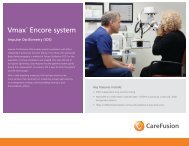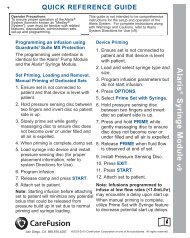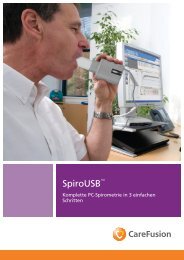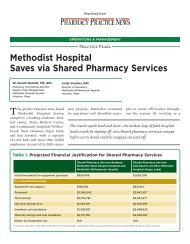LTV 1100 Operator Manual - CareFusion
LTV 1100 Operator Manual - CareFusion
LTV 1100 Operator Manual - CareFusion
Create successful ePaper yourself
Turn your PDF publications into a flip-book with our unique Google optimized e-Paper software.
WARNING<br />
Battery run time - When the battery reaches the BAT LOW level, the ventilator will only run for<br />
approximately 10 minutes before generating a battery empty alarm (BAT EMPTY). The approximate<br />
time shown is based on tests using the nominal settings, a new battery and a full 8 hour charge cycle<br />
as specified in Appendix A - Ventilator Specifications. Actual run time may be more or less depending<br />
on ventilator settings, patient demand, and battery age or condition. It is highly recommended that an<br />
alternate power source is connected PRIOR to the ventilator reaching the BAT EMPTY alarm<br />
condition to ensure continuous, uninterrupted patient ventilation<br />
INOP Alarm - If an INOP alarm occurs during operation, ventilate the patient using an alternative<br />
method, disconnect the ventilator, and immediately contact a certified <strong>CareFusion</strong> service technician<br />
or <strong>CareFusion</strong>.<br />
NO CAL Condition - Operation of the <strong>LTV</strong> ® <strong>1100</strong> ventilator under a NO CAL condition may result in<br />
inaccurate pressure and volume measurements. Should this condition occur, disconnect the patient<br />
from the ventilator, provide an alternative method of ventilation and immediately contact a certified<br />
<strong>CareFusion</strong> service technician or <strong>CareFusion</strong>.<br />
XDCR FAULT Alarm - Continued operation of the <strong>LTV</strong> ® <strong>1100</strong> ventilator with an activated XDCR<br />
FAULT alarm may result in inaccurate flow and volume measurements. Should this condition occur,<br />
disconnect the patient from the ventilator, provide an alternative method of ventilation and<br />
immediately contact a certified <strong>CareFusion</strong> service technician or <strong>CareFusion</strong>.<br />
Personal Injury and Electric Shock - Operation of the <strong>LTV</strong> ® <strong>1100</strong> ventilator if any of its panels have<br />
been removed may result in electrical shock to the patient or operator. All servicing must be<br />
performed by a certified <strong>CareFusion</strong> service technician.<br />
NPPV Mode – NPPV is not a life support mode and is not suitable for patients that require life support<br />
ventilation. NPPV Mode should only be used for supplemental ventilation of non-life support patients.<br />
NPPV Mode - When operating in NPPV mode, many of the standard alarms are disabled. This may<br />
result in reduced ventilation accuracy should a problem occur. Carefully read Chapter 4 - Ventilation<br />
Modes, before selecting this mode of operation.<br />
Audible Alarms - Failure to immediately identify and correct audible alarm situations may result in<br />
serious patient injury.<br />
Equipment Malfunction or Failure - The <strong>LTV</strong> ® <strong>1100</strong> ventilator has alarms to notify operators of<br />
certain conditions and to cease operating upon detecting possible danger. In the event of equipment<br />
failure, all ventilator operators should have an alternative method of ventilation available and be fully<br />
familiar with emergency ventilation procedures.<br />
Improperly Functioning Ventilator - Operation of a ventilator that does not appear to be working<br />
properly may be hazardous. If the ventilator is damaged, fails Ventilator Checkout tests or<br />
malfunctions in any way, discontinue its use and immediately contact a certified <strong>CareFusion</strong> service<br />
technician or <strong>CareFusion</strong>.<br />
Ventilator Checkout Tests – Be aware that gas is not delivered to the patient during these tests.<br />
Disconnect the patient from the ventilator and ventilate the patient using an alternative method before<br />
running the Ventilator Checkout tests.<br />
Ventilator Checkout and Maintenance Modes - The <strong>LTV</strong> ® <strong>1100</strong> ventilator does not deliver gas<br />
during the Ventilator Checkout mode (VENT CHECK) or Ventilator Maintenance mode (VENT<br />
MTNCE) and should not be used to ventilate a patient during these tests.<br />
Inspired Oxygen (FIO 2 ) Concentration – If the patient has a variable respiratory rate, his/her minute<br />
ventilation will fluctuate. If exact concentrations of inspired oxygen (FIO 2 ) are required to be delivered<br />
to the patient, it is recommended that an accurate oxygen analyzer with alarms be used.<br />
1-4 <strong>Operator</strong>’s <strong>Manual</strong> - <strong>LTV</strong> ® <strong>1100</strong> Ventilator 21106-001 Rev. E



